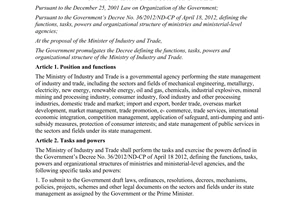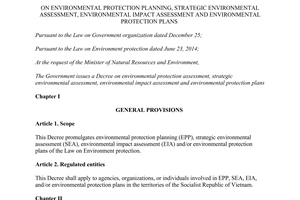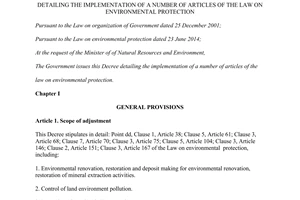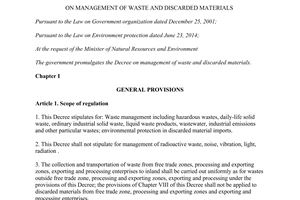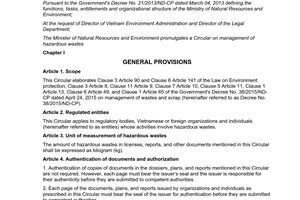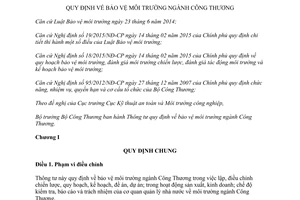Nội dung toàn văn Circular No. 35/2015/TT-BCT environmental protection in the industry and trade sector
|
THE MINISTRY
OF INDUSTRY AND TRADE |
THE
SOCIALIST REPUBLIC OF VIETNAM |
|
No. 35/2015/TT-BCT |
Hanoi, October 27, 2015 |
CIRCULAR
ON ENVIRONMENTAL PROTECTION IN THE INDUSTRY AND TRADE SECTOR
Pursuant to the June 23, 2014 Law on Environmental Protection;
Pursuant to the Government's Decree No. 19/2015/ND-CP of February 14, 2015, detailing a number of articles of the Law on Environmental Protection;
Pursuant to the Government’s Decree No. 18/2015/ND-CP of February 14, 2015, prescribing environmental protection master plans, strategic environmental assessment, environmental impact assessment and environmental protection plans;
Pursuant to the Government’s Decree No. 95/2012/ND-CP of November 12, 2012, defining the functions, tasks, powers and organizational structure of the Ministry of Industry and Trade;
At the proposal of the Director of the Industrial Safety Techniques and Environment Agency;
The Minister of Industry and Trade promulgates the Circular on environmental protection in the industry and trade sector.
Chapter I
GENERAL PROVISIONS
Article 1. Scope of regulation
This Circular prescribes environmental protection in the industry and trade sector in formulation and adjustment of strategies, master plans, plans, schemes and projects; production and business activities; examination and reporting regimes, and responsibilities of environment state management agencies in the industry and trade sector.
Article 2. Subjects of application
This Circular applies to organizations and individuals that are engaged in investment, production and business in Vietnam in sectors and fields under the Ministry of Industry and Trade’s management, and other rEIAted organizations and individuals.
Chapter II
ENVIRONMENTAL PROTECTION IN FORMULATION OF STRATEGIES, MASTER PLANS AND PLANS
Article 3. Compilation of strategic environmental assessment reports
1. The Planning Department shall annually summarize and report to leaders of the Ministry of Industry and Trade for approval the list of sectoral development strategies, master plans and plans which are subject to compilation of strategic environmental assessment reports (below referred to as SEA reports).
2. Based on the approved list, the unit assigned to formulate the industry and trade sector’s development strategies, master plans and plans (below referred to as responsible unit), shall outline, and estimate costs for compilation of, SEA reports, and submit them to leaders of the Ministry of Industry and Trade for approval.
3. The responsible unit shall make SEA reports in accordance with Article 8 of the Government’s Decree No. 18/2015/ND-CP of February 14, 2015, prescribing environmental protection master plan, strategic environmental assessment, environmental impact assessment and environmental protection plan (below referred to as Decree No. 18/2015/ND-CP) in the course of formulation or adjustment of the industry and trade sector’s development strategies, master plans and plans, and, concurrently ask for opinions of the Industrial Safety Techniques and Environment Agency, the Planning Department and rEIAted agencies and units on SEA reports before sending them for appraisal under regulations.
4. Forms and contents of SEA reports must comply with Appendices 1.2 and 1.3 to the Ministry of Natural Resources and Environment’s Circular No. 27/2015/TT-BTNMT of May 29, 2015, on strategic environmental assessment, environmental impact assessment and environmental protection plans (below referred to as Circular No. 27/2015/TT-BTNMT).
Article 4. Appraisal and approval of SEA reports
1. The responsible unit shall make dossiers of request for appraisal of SEA reports in accordance with Clause 1, Article 3 of Circular No. 27/2015/TT-BTNMT and send them to competent agencies mentioned in Clause 1, Article 16 of the Law on Environmental Protection for appraisal.
The appraisal must comply with Article 10 of Decree No. 18/2015/ND-CP and Chapter V of Circular No. 27/2015/TT-BTNMT.
2. For strategies, master plans and plans falling within the approval competence of the Ministry of Industry and Trade, the responsible unit shall make dossiers of request for appraisal of SEA reports and send them to the Industrial Safety Techniques and Environment Agency for appraisal and then report these strategies, master plans and plans to leaders of the Ministry for consideration and approval. The order is as follows:
a/ Within 30 (thirty) working days after the receipt of a compete and valid dossier, the appraisal agency shall appraise the SEA report;
b/ Within 5 (five) working days after the end of the Appraisal Council’s meeting, the appraisal agency shall notify in writing the appraisal result to the responsible unit;
c/ Within 30 (thirty) working days after receiving the appraisal result, the responsible unit shall, based on the appraisal opinion, complete the SEA report, include the SEA implementation result in the draft strategy, master plan or plan and send the dossier on the SEA report to the appraisal agency in accordance with Clause 1, Article 5, Circular No. 27/2015/TT-BTNMT.
Article 5. Funds for compilation and appraisal of SEA reports
1. Funds for compilation of SEA reports shall be included in the funds for formulation of strategies, master plans and plans and covered by the state budget’s economic non-business funds or other funding sources (if any).
2. Funds for appraisal of SEA reports shall be included in state budget’s non-business funds for environmental protection.
Chapter III
ENVIRONMENTAL PROTECTION IN THE INVESTMENT PROJECT FORMULATION PHASE
Article 6. Compilation of environmental impact assessment reports and environmental protection plans
1. Project owners falling in any of the cases specified in Clause s, Article 33 of the Law on Environmental Protection and Appendix II to Decree No. 18/2015/ND-CP shall compile environmental impact assessment reports (below referred to as EIA reports) in accordance with Article 12 of Decree No. 18/2015/ND-CP EIA reports shall be formulated in the project preparation phase.
Forms and contents of EIA reports must comply with Appendices 2.2 and 2.3 to Circular No. 27/ 2015/TT-BTNMT.
2. Project owners falling in the case specified in Article 29 of the Law on Environmental Protection shall register environmental protection plans under Article 18 of Decree No. 18/2015/ND-CP and Article 33 of Circular No. 27/2015/TT-BTNMT in the investment preparation phase.
Forms and contents of environmental protection plans must comply with Appendices 5.4, 5.5 and 5.6 to Circular No. 27/2015/TT-BTNMT.
Article 7. Appraisal and approval of EIA reports
1. The project owner shall prepare a dossier on the EIA report under Article 6 of Circular No. 27/2015/TT-BTNMT and send it to the appraisal agency mentioned in Clause 1, Article 14 of Decree No. 18/2015/ND-CP for appraisal and approval.
The appraisal of the EIA report shall be conducted by the Appraisal Council and must comply with Circular No. 27/2015/TT-BTNMT.
2. The appraisal agency shall send a written notice to the project owner to pay EIA report appraisal charges in accordance with the Finance Ministry’s Circular No. 218/2010/TT-BTC of December 29, 2010, prescribing rates and collection, payment and use management of EIA appraisal charges, or other relevant regulations.
3. After receiving the appraisal result, the project owner shall modify and complete the EIA report and send it to the appraisal agency for consideration and submission to the competent agency for approval.
4. For a project falling within the Ministry of Industry and Trade’s investment decision and approval competence but outside the list of projects specified in Appendix III to Decree No. 18/2015/ND-CP its owner shall make a dossier of request for appraisal of the EIA report under regulations and send it to the Industrial Safety Techniques and Environment Agency for appraisal and then submit it to leaders of the Ministry of Industry and Trade for approval. The order is as follows:
a/ Within 30 (thirty) working days after the receipt of a compete and valid dossier, the appraisal agency shall appraise the EIA report;
b/ Within 5 (five) working days after the end of the Appraisal Council’s meeting, the appraisal agency shall notify in writing the appraisal result to the project owner;
c/ Within 20 (twenty) working days after receiving the appraisal result, the project owner shall, based on the appraisal opinion, complete the EIA report and send it to the appraisal agency for submission to leaders of the Ministry of Industry and Trade for consideration and approval.
Article 8. Examination and certification of the completion of environmental protection facilities serving the project operation phase
For projects subject to certification of the completion of environmental protection facilities specified m Appendix II to Decree No. 18/2015/ND-CP then owners shall make dossiers of reports on the implementation results of environmental protection facilities and send them to EIA report approval agencies for examination and certification before official commissioning of the projects.
Article 9. Funds for compilation and appraisal of EIA reports
1. Funds for compilation of EIA reports shall be included in projects’ investment funds.
2. Funds for appraisal of EIA reports shall be covered by revenues from appraisal charges of EIA reports.
3. Funds for examination and certification of the completion of environmental protection facilities serving the project operation phase shall be covered by environmental non-business funds.
Article 10. Environmental protection regulations in the phase of formulation of investment projects for a number of specific fields
1. For projects involving the exploitation of surface water (including seawater) or exploitation and use of groundwater serving production and business activities, surface water, groundwater or seawater exploitation and use licenses are required under regulations on management of water resources.
2. For projects involving the discharge of wastewater into receiving waters, dossiers of application for licenses to discharge wastewater into water sources are required under regulations on management of water resources, except the discharge of wastewater into the centralized wastewater collection and disposal system already licensed to discharge wastewater into water sources under wastewater treatment or drainage agreements or contracts with organizations or individuals managing the operation of such system.
3. For a project to build hydropower plants with reservoirs, before storing water, its owner shall EIAborate a reservoir clean-up plan and submit it to the EIA report approval agency for examination and written approval.
4. For mining projects
a/ To formulate plans and implement environmental rehabilitation and restoration schemes for the whole mining process and submit them to competent management agencies for approval under regulations;
b/ To pay a deposit for environmental rehabilitation and restoration.
Chapter IV
ENVIRONMENTAL PROTECTION IN PRODUCTION AND BUSINESS ACTIVITIES
Article 11. General environmental protection regulations for production and business establishments
Owners of production and business establishments shall:
1. Formulate and list environment management plans at the head office of the commune- level People’s Committee of the locality where production and business activities are carried out after the EIA reports are approved.
2. Operate environmental protection facilities: household and production wastewater and gas emission collection and disposal system according to the process approved in the certified EIA report or environmental protection plan.
3. Classify and manage household and ordinary industrial solid waste under the Government’s Decree No. 38/2015/ND-CP of April 24, 2015, on management of wastes and scraps. Sign a contract with the ordinary solid waste collection, transportation and disposal unit in case they do not conduct disposal by themselves.
4. For hazardous waste, compile a waste source owner registration book, classify the waste in different groups, store it in storehouses and manage it in accordance with the Ministry of Natural Resources and Environment’s Circular No. 36/2015/TT-BTNMT of June 30, 2015, on hazardous waste management.
5. For production activities on the list of large-flow gas emission sources provided in Appendix 1 to this Circular, register industrial gas emission source owners under Article 45 of the Government’s Decree No. 38/2015/ND-CP of April 24, 2015, on management of wastes and scraps.
6. Conduct environmental monitoring for parameters and frequencies in EIA reports, environmental protection plans or approved and certified equivalent documents (monitoring units must possess a certificate of eligibility for provision of environmental monitoring services in accordance with law).
Production and business establishments outside industrial parks with a daily discharge volume of 1,000 m3 of wastewater or more (excluding cooling water) shall install constant automatic wastewater monitoring systems.
For gas emissions, establishments on the list provided in Appendix 1 to this Circular shall install constant automatic gas emission monitoring systems.
The system of monitoring equipment shall be inspected and calibrated under regulations to ensure the reliability of monitoring data.
7. Develop the environmental management system
a/ Production and business establishments on the list provided in Appendix 2 to this Circular shall certify the environmental management system;
b/ Production and business establishments on the list provided in Appendix 2 to this Circular using the environmental management system meeting national standard TCVN ISO 14001 which remains valid are not required to develop the environmental management system but shall commit to implementing the provisions of Article 27 of the Government’s Decree No. 19/2015/ND-CP of February 14,2015, detailing a number of articles of the Law on Environmental Protection.
Article 12. Environmental protection in the import of scraps from abroad for use as production raw materials
1. Organizations and individuals may only import from abroad the scraps on the Prime Minister-issued list for use as production raw materials.
2. Organizations and individuals that directly use imported scraps as production raw materials or undertake the entrusted import must possess certificates of eligibility for environmental protection in the import of scraps granted by environment management agencies and shall pay a deposit for imported scrap security in accordance with the Government’s Decree No. 38/2015/ND-CP of April 24, 2015, on management of wastes and scraps.
Article 13. Response to environmental incidents
1. Production and business establishments shall formulate plans and schemes and prepare physical and technical foundations to respond to, and remedy the consequences of, environmental incidents.
2. In case of occurrence of an environmental incident, the production and business establishment shall directly report such incident and remedial measures to the state management agency in charge of environmental protection and concurrently to the provincial-level Department of Industry and Trade of the locality where the incident occurs and the superior management unit for summarization and reporting to the Ministry of Industry and Trade.
3. A mineral exploitation and processing establishment having a tailings reservoir shall formulate and approve an operation scheme and a plan on prevention of and response to environmental incidents of the reservoir and send them to the provincial-level Department of Industry and Trade and Department of Natural Resources and Environment for monitoring and supervision.
4. Environmental management agencies of the industry and trade sector shall:
a/ Investigate, make statistics of, and assess dangers of environmental incidents in the industry and trade sector;
b/ Build capacity to prevent, warn dangers of, and respond to, environmental incidents in the industry and trade sector;
c/ Work out annual and five-year plans on prevention of and response to environmental incidents in the industry and trade sector.
Chapter V
EXAMINATION OF AND REPORTING ON ENVIRONMENTAL PROTECTION WORK
Article 14. Examination of environmental protection work
1. Annually, environmental management agencies of the industry and trade sector shall formulate examination plans and organize their implementation. The examination contents of environmental protection work cover examination of the compliance with the law on environmental protection and the fulfillment of commitments in environmental management plans.
2. The planned periodical examination shall be notified in writing 7 (seven) working days in advance. In an extraordinary case, when a sign of violation of environmental protection regulations is detected or a denunciation is lodged, the examination may be conducted without written notification in advance.
3. Production and business establishments shall:
a/ Examine their compliance with the law on environmental protection and their commitments;
b/ Observe examination decisions, strictly comply with conclusions of examination delegations and take responsibility before law for their violations of the law on environmental protection.
Article 15. Reporting on environmental work
1. Reporting on environmental work of production and business establishments
a/ Reporting on environmental work shall be carried out periodically once a year;
b/ Groups, corporations and enterprises of the Ministry of Industry and Trade shall report on environmental work in accordance with the Ministry of Industry and Trade’s Circular No. 22/2013/TT-BCT of October 14, 2013, prescribing the declaration, management and use of the industry and trade sector’s environmental database;
c/ Production and business establishments in the industry and trade sector not mentioned at Point b, Clause 1, Article 15 of this Circular shall send reports to provincial-level Departments of Industry and Trade before March 31 of the year following the reporting year, made according to the form provided in Appendix 3 to this Circular, for summarization and reporting to the Ministry of Industry and Trade;
d/ In an extraordinary case, the Ministry of Industry and Trade shall request units to report or provide information in writing.
2. Environmental reports of the industry and trade sector
The Industrial Safety Techniques and environment Agency shall make annual and five-year environmental reports in the fields under the Ministry of Industry and Trade’s management and send them to the Ministry of Natural Resources and Environment under regulations.
Chapter VI
IMPLEMENTATION PROVISIONS
Article 16. Responsibilities of agencies under the Ministry of Industry and Trade’s
1. The Industrial Safety Techniques and Environment Agency, an environmental management agency of the Ministry of Industry and Trade, shall:
a/ Appraise SEA and EIA reports which fall within the approval competence of the Minister of Industry and Trade. Examine and supervise the satisfaction of environmental protection requirements mentioned in SEA and EIA reports;
b/ Make statistics of environmental indicators of the industry and trade sector; develop and manage the sector’s environmental database;
c/ Urge and examine the implementation of handling measures by seriously polluting establishments in the industry and trade sector;
d/ Act as the focal point of the industry and trade sector in the prevention of, response to and remedy of environmental incidents, and in environment restoration;
dd/ Guide, direct, examine, summarize and report on environmental protection work in the industry and trade sector in accordance with law and this Circular.
2. The Planning Department shall take charge of summarizing and submitting to the Ministry’s leaders the list of sectoral development strategies, master plans and plans for approval which are subject to formulation of EIA reports according to this Circular.
3. The Ministry’s units assigned to formulate sectoral development strategies, master plans and plans, schemes and projects shall collaborate with the Industrial Safety Techniques and Environment Agency and rEIAted agencies in formulating, appraising and submitting SEA and EIA reports for approval.
Article 17. Responsibilities of provincial-level Departments of Industry and Trade
1. To examine under provincial-level People’s Committees’ instruction or coordinate with the environmental management agency of the Ministry of Industry and Trade in examining the implementation of the law on environmental protection in accordance with law and this Circular.
2. To summarize and compile reports on environmental work in the industry and trade sector in localities and send them to the Ministry of Industry and Trade, made according to the form provided in Appendix 4 to this Circular, before April 30 of the year following the reporting year.
Article 18. Responsibilities of production and business establishments
1. To comply with the laws on environmental protection, inspection and examination, handling of violations, and reporting on environmental protection in accordance with law and this Circular.
2. To formulate and disseminate environmental management plans to the cadres and employees of the establishments, review and evaluate environmental protection results at the establishments.
3. In addition to the above regulations, groups and corporations of the Ministry of Industry and Trade shall:
a/ Formulate environmental protection regulations for groups and corporations and guide member units to compile environmental work reports in accordance with this Circular;
b/ Consider the establishment of a division in charge of environment or assign full-time personnel to assist the establishments’ leaders in managing environmental protection activities.
Article 19. Implementation provisions
1. This Circular takes effect on December 10, 2015.
2. The Minister of Industry and Trade’s Decision No. 52/2008/QD-BCT of December 30, 2008, promulgating the Temporary Regulation on environmental protection in the industry and trade sector, ceases to be effective on the effective date of this Circular.
3. In case legal documents or standards referred to in this document are changed, modified or replaced, the regulations in the new document shall be complied with.
4. Any problems or difficulties arising in the course of implementation should be promptly reported to the Ministry of Industry and Trade for consideration and decision.-
|
|
FOR THE
MINISTER OF INDUSTRY AND TRADE |
APPENDIX 1
LIST OF LARGE-FLOW GAS EMISSION SOURCES
(To the Minister of Industry and Trade s Circular No. 35/2015/TT-BCT of
October 27, 2015)
|
No. |
Types of production establishments |
Scale/Capacity |
|
1 |
Steel ingot production |
More than 200,000 tons per year |
|
2 |
Thermal power |
Except natural gas-fuelled thermal power plants |
|
3 |
Chemicals and chemical fertilizers |
More than 10,000 tons per year |
|
4 |
Petroleum production |
More than 10,000 tons per year |
|
5 |
Industrial steam boilers |
More than 20 tons of steam per hour |
APPENDIX 2
LIST OF TYPES OF
PRODUCTION ESTABLISHMENTS REQUIRED TO CERTIFY THEIR ENVIRONMENTAL MANAGEMENT
SYSTEMS
(To the Minister of Industry and
Trade's Circular No. 35/2015/TT-BCT of October 27, 2015)
|
No. |
Types of production establishments |
Scale/Capacity |
|
1 |
Production establishments containing radioactive substances or generating radioactive waste |
Exceeding the exemption level prescribed by the law on radiation safety and control |
|
2 |
Oil refining and petrochemical plants; oil and gas exploitation establishments |
All |
|
3 |
Basic chemical, paint and printing ink, rubber, pesticide, detergent, additive and chemical fertilizer manufacturing establishments |
10,000 tons of products or more per year |
|
4 |
Rare earth and radioactive mineral exploiting, sorting and enriching establishments |
50,000 tons of products or more per year |
|
5 |
Battery manufacturing establishments |
300,000 KWh or 600 tons of products or more per year |
|
6 |
Establishments exploiting solid minerals (including waste rock and minerals) |
500,000 m3 of primitive products or more per year |
|
7 |
Rare earth, non-ferrous metal and radioactive mineral processing establishments |
200,000 tons of products or more per year |
|
8 |
Cast iron and steel establishments |
200,000 tons of products or more per year |
|
9 |
Industrial clusters |
200 hectares or more |
|
10 |
Pulp mills |
25,000 tons of products or more per year |
|
11 |
Alcohol and liquor plants |
1 million liters of products or more per year |
|
12 |
Beer and soft drink plants |
50 million liters of products or more per year |
